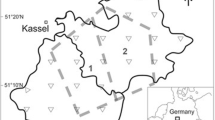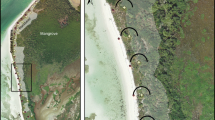Abstract
We conducted a validation of the line transect technique to estimate densities of orangutan (Pongo pygmaeus) nests in a Bornean swamp forest, and compared these results with density estimates based on nest counts in plots and on female home ranges. First, we examined the accuracy of the line transect method. We found that the densities based on a pass in both directions of two experienced pairs of observers was 27% below a combined sample based on transect walks by eight pairs of observers, suggesting that regular line-transect densities may seriously underestimate true densities. Second, we compared these results with those obtained by nest counts in 0.2-ha plots. This method produced an estimated 15.24 nests/ha, as compared to 10.0 and 10.9, respectively, by two experienced pairs of observers who walked a line transect in both directions. Third, we estimated orangutan densities based on female home range size and overlap and the proportion of females in the population, which produced a density of 4.25–4.5 individuals/km2 . Converting nest densities into orangutan densities, using locally estimated parameters for nest production rate and proportion of nest builders in the population, we found that density estimates based on the line transect results of the most experienced pairs on a double pass were 2.82 and 3.08 orangutans/km2, based on the combined line transect data are 4.04, and based on plot counts are 4.30. In this swamp forest, plot counts therefore give more accurate estimates than do line transects. We recommend that this new method be evaluated in other forest types as well.

Similar content being viewed by others
References
Ancrenaz M, Gimenez O, Ambu L, Ancrenaz K, Andau P, Goossens B, Payne J, Sawang A, Tuuga A, Lackman-Ancrenaz I (2005) Aerial surveys give new estimates for orangutans in Sabah, Malaysia. PLoSBiology 3(1,e3):1–8
Buckland ST, Anderson DR, Burnham KP, Laake JL (1993) Distance sampling: estimating abundance of biological populations. Chapman and Hall, London
Buij R, Wich SA, Lubis AH, Sterck EHM (2002) Seasonal movements in the Sumatran orangutan (Pongo pygmaeus abelii) and consequences for conservation. Biol Cons 107:83–87
Buij R, Singleton I, Krakauer E, van Schaik CP (2003) Rapid assessment of orangutan density. Biol Cons 114:103–113
Cowlishaw G, Dunbar R (2000) Primate conservation biology. University of Chicago Press, Chicago
Ghiglieri MP (1984) The chimpanzees of Kibale forest. Columbia University Press, N.Y.
Hashimoto C (1995) Population census of the chimpanzees in the Kalinzu forest, Uganda: comparison between methods with nest counts. Primates 36:477–488
Johnson AE, Knott CD, Pamungkas B, Pasaribu M, Marshall AJ (2005) A survey of the orangutan (Pongo pygmaeus pygmaeus) population in and around Gunung Palung National Park, West Kalimantan, Indonesia based on nest counts. Biol Cons (in press)
Morrogh-Bernard H, Husson S, Page SE, Rieley JO (2003) Population status of the Bornean orang-utan (Pongo pygmaeus) in the Sebangau peat swamp forest, Central Kalimantan, Indonesia. Biol Cons 110:141–152
Rijksen HR, Meijaard E (1999) Our vanishing relative: The status of wild orang-utans at the close of the twentieth century. Kluwer, Boston
Russon AE, Erman A, Dennis R (2001) The population and distribution of orang-utans (Pongo pygmaeus pygmaeus) in and around the Danau Sentarum Wildlife Reserve, West Kalimantan, Indonesia. Biol Cons 97:21–28
van Schaik CP, Azwar, Priatna D (1995) Population estimates and habitat preferences of orangutans based on line transects of nests. In: Nadler RD, Galdikas BMF, Sheeran LK, Rosen N (eds) The neglected ape. Plenum Press, N.Y., pp129–147
van Schaik CP, Monk KA, Robertson JMY (2001) Dramatic decline in orang-utan numbers in the Leuser ecosystem, Northern Sumatra. Oryx 35:14–25
Singleton IS (2000) Ranging behaviour and seaasonal movements of sumatran orangutans (Pongo pygmaeus abelii) in Swamp Forests. PhD dissertation, University of Kent
Singleton IS, van Schaik CP (2002) The social organization of a population of Sumatran orangutans. Folia Primatol 73:1-20
Thomas L, Laake JL, Strindberg S, Marques FFC, Borchers DL, Buckland ST, Anderson DR, Burnham KP, Hedley SL, Pollard JH (2001) Distance 4.0. Beta 3. Research unit for wildlife population assessment. University of St. Andrews, UK
Wich SA, Singleton I, Utami-Atmoko SS, Geurts ML, Rijksen HD, van Schaik CP (2003) The status of the sumatran orangutan Pongo abelii: an update. Oryx 37:49–54
Acknowledgements
We thank the BOS-Foundation for permission to work at Mawas, and its staff for the great support of all activities; the staff and students from Universitas Nasional, Jakarta (Tatang Mitra Setia, Imran Said L. Tobing, Didik Prasetyo, Dwi Mulyawati, Tirza Yohana, Lili Aries Sadikin, Adi Hadinata, Ari Meididit, Fikty Apirlinayati, Fitriah Basalamah, and Ika Mian Karlina) for participating in the line transect experiment; the Indonesian Institute of Sciences (LIPI) for permission to work in Indonesia; the L.S.B. Leakey Foundation for financial support of the Tuanan Orangutan Project; the Netherlands Organisation for Scientific Research for financially supporting S.A. Wich, and Meredith Bastian and Maria van Noordwijk for comments on the MS.
Author information
Authors and Affiliations
Corresponding author
About this article
Cite this article
van Schaik, C.P., Wich, S.A., Utami, S.S. et al. A simple alternative to line transects of nests for estimating orangutan densities. Primates 46, 249–254 (2005). https://doi.org/10.1007/s10329-005-0134-z
Received:
Accepted:
Published:
Issue Date:
DOI: https://doi.org/10.1007/s10329-005-0134-z




